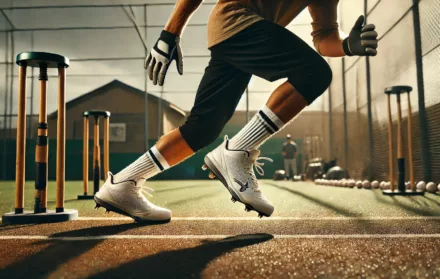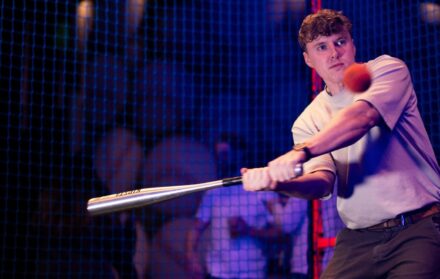
How to Swing a Baseball Bat Faster?
Understanding how to swing a baseball bat faster is essential for any player seeking to elevate their offensive game and become a formidable presence at the plate. A quicker swing translates directly into more power and greater potential for hard-hit balls, making this skill a top priority for both baseball for beginners and seasoned athletes. To swing the bat faster, you need to understand how body mechanics, strength training, and mental focus all contribute to seamless, explosive motion. By aligning these elements effectively, you give yourself the best chance of making consistent contact and driving the ball with authority.
A solid starting point is to assess your hitting fundamentals. Evaluating your stance, grip, and timing allows you to isolate inefficiencies that may be slowing down your swing. Some players rely too heavily on their arms, resulting in a sluggish bat path that produces weak grounders or easy fly balls. Others struggle with balance, losing energy in their legs or twisting their core in unproductive ways. By taking inventory of these areas, you can begin a targeted improvement plan that hones each aspect of your swing sequence.
Additionally, building muscular strength and cultivating strong hand-eye coordination are indispensable for a quicker swing. Combining weightlifting routines with baseball hitting drills ensures your athletic gains are translated into practical results on the diamond. Moreover, the mental side of batting—staying calm under pressure, reading baseball pitching techniques, and committing to the right pitch—forms a key foundation for explosive swings.
We’ll delve into crucial strategies to enhance your swing speed, focusing on topics ranging from optimizing your stance to employing specialized drills and embracing a confident mindset. By dedicating yourself to these methods, you’ll see dramatic improvements in your bat speed, leading to more solid hits, higher on-base percentages, and an overall greater impact in the batter’s box.
1. Building a Strong Foundation Through Proper Stance

Developing proper stance is the groundwork for swinging a baseball bat faster. Your feet, legs, and core all influence how you generate momentum during the swing, so placing them correctly is vital. A wide enough base helps distribute your weight evenly, allowing you to remain balanced throughout the motion. Bend your knees slightly and keep your hips relaxed yet poised for rotation—this encourages the lower body to initiate force when you pivot. Align your toes toward home plate, ensuring that you feel stable but not rigid, ready to react to different pitch locations.
Once your lower body is set, turn your attention to your upper body. A sturdy foundation means little if you’re off-balance above the waist. Hold the bat at a comfortable angle, with your hands positioned near the back shoulder. Many baseball coaching tips emphasize that your elbows should stay relaxed, not flared out or pinned too tightly against your body. This posture promotes a dynamic flow when you start your swing, allowing your arms to fully extend without wasting energy.
Mental preparation also factors into building the right stance. Whether you’re in youth baseball leagues or pursuing competitive ranks, stepping into the batter’s box with a focused mindset cultivates confidence. Visualize making solid contact, reminding yourself to trust in your stance as a launchpad for explosive movement. Over time, this mental reinforcement pairs with muscle memory to create a fluid stance that supports faster bat speed. By synchronizing physical setup with mental readiness, you’ll establish a consistent, powerful stance that serves as the cornerstone of your entire swing.
2. Refining Bat Grip and Hand Position
To swing a baseball bat faster, you must grasp the importance of a secure yet flexible bat grip. Start by placing your dominant hand near the bottom of the handle, letting your fingers wrap naturally around it. Position your other hand just above, aligning the knuckles to maintain a unified hold. The goal is to avoid a “death grip,” which can stifle wrist action, reduce bat speed, and lead to tension in your forearms. Instead, aim for a firm-but-relaxed hold that feels natural and allows you to adjust mid-swing if necessary.
Hand alignment also influences how quickly you can whip the bat through the hitting zone. Even slight shifts in angle can affect whether the barrel lags or strikes the ball prematurely. When you keep your hands in close to your body, you maintain better bat control and increase your potential to react quickly to off-speed pitches. Many famous baseball players stress the importance of minimizing wasted motion in the swing, and fine-tuning your grip helps eliminate extraneous movements that sap bat speed.
Developing feel and consistency in your bat grip often requires repetition through baseball hitting drills or soft toss sessions. Pay attention to how each adjustment—like spreading your fingers or rotating your top hand—affects swing speed and contact quality. Feedback from coaches or slow-motion video can highlight subtle grip errors. By systematically refining hand placement, you create an agile base that supports a faster swing, boosting both power and accuracy at the plate. Over time, this deliberate approach transforms gripping the bat into a reflexive skill that propels consistent, lightning-quick swings.
3. Harnessing Core Strength and Explosive Hip Rotation

Generating bat speed isn’t solely about your arms; tapping into core strength and leveraging hip rotation are both critical for a faster, more powerful swing. Many hitters overlook the role of the lower body, believing that upper-body force alone can deliver explosive results. However, dynamic swings begin from the ground up, using the legs, hips, and abdomen to create rotational torque. By letting your hips lead the movement, your arms follow naturally, yielding a whip-like effect that speeds up the bat head.
A strong core also stabilizes your spine, giving your swing a reliable axis of rotation. Incorporate exercises like planks, rotational medicine ball throws, and controlled twists into your training routine. These moves improve your torso’s capacity to transfer energy between your lower and upper body, allowing for a smoother, more forceful swing. Combined with consistent practice in baseball drills for kids or adult leagues, boosted core strength translates directly into advanced performance at the plate.
It’s equally important to focus on timing your hip rotation with your forward stride. As you load and step toward the pitch, engage your hips to drive the rotational force. When executed correctly, the energy flows effortlessly through your midsection to your shoulders, ultimately snapping the bat through the zone. Developing this synchronized motion demands repetition and patience, but once mastered, your hips become a powerful engine that elevates bat speed, turning routine hits into line drives and doubles into home runs. Embracing core and hip-centric mechanics will drastically reshape your swing, enhancing both velocity and consistency.
4. Improving Hand-Eye Coordination and Tracking the Ball
Even if you possess excellent mechanics and core strength, you must still enhance hand-eye coordination to swing a baseball bat faster. Speed is useless if your timing and contact point falter. Recognizing the ball’s spin, location, and speed requires constant mental and visual focus. The stronger your coordination, the better you can accelerate the bat head at the right moment to meet the ball squarely.
Begin with simple drills, like soft toss or tee work, focusing on seeing the ball through your swing. Gradually incorporate more challenging exercises, such as front toss from different angles or live batting practice against varied baseball pitching techniques. Concentrate on following the ball from the pitcher’s release point to your contact zone, training your eyes to lock onto the target. This repeated exposure sharpens your visual acuity and forces you to make fine-tuned adjustments without sacrificing speed.
Confidence in your ability to track the ball also influences your mental game. When you trust that you can see the pitch early, you feel more comfortable unleashing a rapid swing. This mental clarity helps you avoid second-guessing or hesitating at the plate, two habits that sabotage speed and power. By merging improved hand-eye coordination with the physical aspects of your swing, you arrive at a balanced approach that boosts bat speed while still connecting with the ball consistently. Over time, these refinements become second nature, strengthening both your hitting confidence and your offensive production.
5. Using Strength and Conditioning Programs Effectively

To swing a baseball bat faster, investing in a strength and conditioning program is paramount. Specifically targeting the muscles used in batting—forearms, wrists, shoulders, core, and legs—creates the physical framework for explosive swings. However, remember that raw strength must harmonize with skill. Lifting heavy alone won’t fix a flawed swing path, so use structured exercises to reinforce a robust foundation while continually refining your mechanics at the plate.
A well-rounded regimen typically involves compound movements like squats, lunges, and deadlifts, which build lower-body power for a potent launch. Supplement these with upper-body lifts such as bench presses and rows to enhance the arm and back muscles. Meanwhile, specialized work—like wrist curls and rotational core exercises—adds nuance to your training by directly addressing the smaller stabilizer muscles crucial for fine motor control. Many baseball coaching tips also advocate bodyweight exercises that promote agility and balance, ensuring you maintain flexibility alongside strength.
Finally, consistency is key. Creating a weekly schedule that alternates between resistance training and batting practice helps you track gradual improvements in bat speed. Overtraining or ignoring rest periods can lead to fatigue and injuries, undoing your hard work. Stay mindful of baseball injuries and prevention strategies, especially as you ramp up intensity. Pair weightlifting with dynamic warm-ups, stretching, and periodic deload weeks to let your body recover. By combining disciplined strength-building with constant mechanical drills, you’ll discover the physical and technical synergy that unlocks quicker, more powerful swings.
6. Employing Specialized Drills and Practice Routines
Dedicated practice routines can be transformative when you’re determined to swing a baseball bat faster. While general batting exercises help maintain form, specialized drills zero in on speed and explosiveness. For example, short-burst hitting sessions that emphasize rapid-fire tosses or machine pitches train your reflexes and acceleration. Repetitive motion at higher speeds teaches your muscles to react quicker without sacrificing technique, accelerating the progression toward a faster swing.
Incorporate drills that isolate crucial phases of the swing. One proven technique is the one-hand drill, where you temporarily remove one hand from the bat to focus on refining each arm’s role independently. Another is the heavy bat or donut drill, which uses added weight to build up your arms and core. By swinging a heavier load, you strengthen the fibers responsible for quick movements. After returning to your regular bat, the newfound lightness fosters an immediate jump in bat speed.
It’s also beneficial to integrate video analysis into your training. Recording your sessions allows you to evaluate your body alignment, stride timing, and follow-through. Look for any hesitations or slow transitions that hinder speed. Over time, these micro-adjustments become part of your muscle memory, ensuring consistency. Whether you’re a baseball for beginners player or a seasoned athlete, specialized routines that blend purposeful drills, targeted practice sessions, and meticulous feedback loops pave a clear path to a more lightning-quick swing.
7. Mastering the Mental Aspect for Faster Swings

The mental aspect of batting plays a pivotal role in swinging a baseball bat faster. Doubt, fear, or overthinking can create hesitation, costing valuable milliseconds that determine whether you square up on a fastball or miss it altogether. By cultivating focus, confidence, and resilience, you free your body to accelerate the bat head without the shackles of self-doubt or constant mechanical scrutiny.
One strategy is visualization. Before stepping into the batter’s box, close your eyes briefly and envision a perfect, lightning-fast swing connecting solidly with the pitch. This mental rehearsal primes your muscles and psyche for high-speed execution. Athletes in Major League Baseball (MLB) regularly adopt such imagery, reinforcing a sense of preparedness that boosts reaction times. When your mind and body align on the idea of swinging explosively, your performance often follows suit.
Additionally, managing pressure is vital. Tight games, rival matchups, or important tryouts can trigger adrenaline spikes that disrupt your normal swing flow. Train your mind to accept pressure as an inevitable part of the game rather than a burden. Use deep breathing, self-talk, or quick resets between pitches to maintain composure. Once you control your mental state, you’ll be able to unleash your swing in a fluid, high-velocity manner. By consistently honing the mental side of batting alongside physical drills, you transform yourself into a more focused, fearless hitter ready to generate impressive bat speed every time you step up to the plate.
8. Conclusion: How to Swing a Baseball Bat Faster

Achieving a faster baseball bat swing demands more than just raw strength or natural talent; it requires a holistic approach that unites mechanics, mental preparedness, and consistent training. By refining your stance, calibrating your grip, and harnessing core strength, you set the stage for swift, explosive motion through the hitting zone. Meanwhile, sharpening your hand-eye coordination ensures you deliver that speed exactly where it’s needed—right on the ball’s sweet spot.
As you progress, supplement skill-building efforts with a solid conditioning program. Compound lifts and isolation work combine to grow the specific muscle groups responsible for launching the bat with power. Pair these workouts with precision baseball hitting drills, focusing on short-burst exercises or heavier bats that push your muscles toward faster adaptions. Throughout these routines, remember to guard against overtraining—allow your body the rest it needs to recover and adapt, preventing fatigue or injuries.
Most importantly, recognize that the mind is as crucial as the body. Cultivating confidence, adopting visualization tactics, and embracing the excitement of competition clear mental hurdles that might otherwise slow you down. When you trust in the synergy between your mental resilience and physical readiness, every swing can reach its maximum velocity. By integrating stance adjustments, consistent practice, and a strong mental game, you’ll forge the fast, dynamic swing that translates into more extra-base hits, higher averages, and a commanding presence at the plate.





